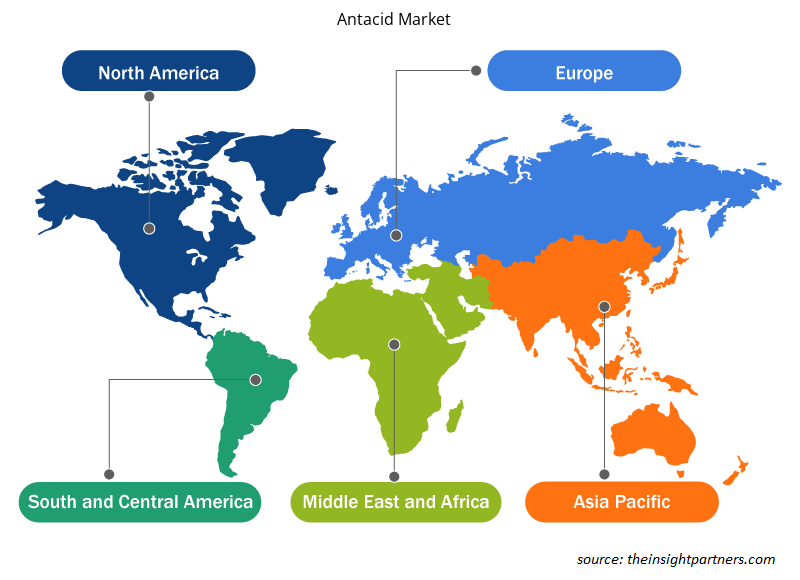2019 年全球抗酸药市场价值为 85.4797 亿美元,预计到 2027 年将达到 116.6683 亿美元,在 2020-2027 年期间以创纪录的 4.0% 的年增长率扩张。
抗酸药属于中和胃酸的药物类。它能有效治疗胃灼热、消化不良、胃酸过多和胃部不适。抗酸药有片剂、胶囊、液体和口服粉末等形式。氢氧化铝、碳酸镁、三硅酸镁、氢氧化镁、碳酸钙和碳酸氢钠是主要的抗酸药。抗酸药的成分有助于控制胃酸的 pH 值。
抗酸药通过医院、零售和网上药店等渠道销售。它们实际上是非处方药 (OTC),也称为非处方药,只要按照标签上的说明或按照相关医疗保健专业人员的指示服用,就可以安全有效地服用。
抗酸市场 - COVID-19 的影响和分析
抗酸药需求持续增长,因为酸性是新冠肺炎药物的副作用之一
由于 COVID-19 全球大流行,抗酸药等基本非处方药 (OTC) 的销售受到影响。制药公司转向非实体营销活动并转向在线销售流程。为防止抗酸药等非处方药缺货,美国颁布了《冠状病毒援助救济和经济安全法案》(CARES),这是一项具有里程碑意义的立法,为受疫情影响的工人、医护人员和小型企业提供经济救济。疫情期间,欧洲对非处方药的需求激增。一些国家限制非处方药的销售和购买,以维持供应并抵消囤积或恐慌性购买。
在疫情期间,亚太抗酸药市场呈现出略有不同且积极的局面。印度是最大的制药中心之一,在制造商满负荷运营的情况下,占据了全球仿制药和品牌药的大部分份额。由于患者意识增强,亚太地区在 COVID-19 疫情期间实行自我药疗。酸度是 COVID-19 药物的常见副作用,这刺激了对抗酸药的需求。全球贸易中断和进口减少导致医疗用品短缺,从而导致中东、南美洲和中美洲价格上涨。无论价格和供应模式如何,在 COVID-19 疫情期间,全球对抗酸药的总体需求都得到了提升。
抗酸药市场未来趋势
多家抗酸药制造商致力于开发和推出新产品,以扩大其地理覆盖范围和产能,满足庞大的消费者群体。全球领先的消费者保健公司葛兰素史克消费者保健公司推出了 ENO Cooling,这是一款可立即缓解酸度并带来即时清凉感的产品。2017 年 5 月,总部位于孟买的 Piramal Enterprises 推出了一种名为 Polycrol 的槟榔味抗酸药,它不仅可以缓解酸度,而且还具有宜人的口感。2020 年 10 月,印度跨国制药公司 Dr. Reddy's Laboratories 在美国市场推出了非处方仿制药法莫替丁片,用于治疗胃食管反流病。此外,太阳制药有限公司推出了其首款消费者保健产品 Pepmelt,这是一种口溶颗粒状药物。
定制此报告以满足您的需求
您可以免费定制任何报告,包括本报告的部分内容、国家级分析、Excel 数据包,以及为初创企业和大学提供优惠和折扣
-
获取此报告的关键市场趋势。这个免费样品将包括数据分析,从市场趋势到估计和预测。
抗酸药市场驱动因素
胃食管反流病 (GERD) 患病率不断上升
胃食管反流病是一种消化系统疾病,会影响食管和胃之间的肌肉环。根据 2014 年发表的《GERD 流行病学最新进展:系统评价》报告的统计,该病的患病率为北美 18.1–27.8%、东亚 2.5–7.8% 和欧洲 8.8–25.9%。此外,2015 年进行的国家胃肠道调查显示,在接受测试的 71,000 人中,18% 的患者每周发作 2 次 GERD,31% 的患者每周至少发作一次 GERD。此外,调查还发现该病在女性中更为常见。近 35% 的 GERD 患者使用药物,而 55% 的患者首选质子泵抑制剂作为药物治疗。
肥胖病例增加
肥胖是引发 GERD 的主要危险因素。腹部脂肪过多会对胃造成压力,而食管裂孔疝会导致胃酸反流。此外,肥胖人群下食管括约肌 (LES) 松弛度增加会导致胃酸反流增多。大多数超重或 BMI 较高(25-30 千克/平方米)的人都患有胃酸过多或 GERD。根据世界卫生组织的数据,2016 年有超过 19 亿成年人超重,其中约 6.5 亿人肥胖。2017-2018 年,美国的肥胖患病率为 42.4%。肥胖一直是中国的主要健康问题,2004 年至 2014 年间,肥胖病例增加了三倍多。除了 GERD 之外,肥胖体质还会导致许多其他需要使用抗酸药等非处方药治疗的疾病,因此有利于全球抗酸药市场的增长。
抗酸药市场限制
低收入经济体缺乏与胃肠道疾病相关的认知
由于行为和社会心理方面的原因,大多数人不愿在早期报告疾病。此外,对筛查方法的认识和采用程度较低往往会偏离治疗,从而危及健康程度。尽管取得了重大进展,但许多胃肠道疾病仍然没有得到很好的解释,需要安全、新颖和有效的治疗方法。由于环境因素的变化、饮食习惯和抗生素的过度使用,这些疾病在发展中经济体中更为普遍。在低收入国家,GERD、溃疡性结肠炎和克罗恩病等常见胃肠道疾病仍然需要最佳筛查和诊断。多种消化系统疾病需要进行广泛而昂贵的诊断测试,例如内窥镜检查、超声检查、CAT 扫描或 MRI。然而,基础设施的缺乏和缺乏熟练的专业人员阻碍了消化系统疾病的筛查。
抗酸药市场按剂型细分
易于储存,剂量适宜,可提高节段控制率
根据剂型,全球抗酸药市场分为片剂、液体和其他类型。其中,片剂在 2019 年占据了市场主导地位,其次是液体,占据第二大市场份额,但在预测期内以最高的复合年增长率增长。市场上有各种类型的抗酸药片,包括可咀嚼的软糖、普通片剂和水溶性片剂。与其他形式相比,这些片剂易于储存,可提供足够的剂量。
液体剂型对于吞咽固体药丸有困难的患者很有用,因为液体药物的吸收速度比固体剂量更快。此外,由于其味道鲜美,非常适合儿童和老年人使用。宝洁、辉瑞、葛兰素史克集团等主要市场参与者提供液体抗酸药来推动细分市场的增长。
抗酸药市场按药物类别细分
先进的药物输送系统和日益增多的胃肠道疾病助长了该领域的主导地位
根据药物类别,抗酸药市场包括质子泵抑制剂 (PPI)、H2 拮抗剂和酸中和剂,其中质子泵抑制剂部分在 2019 年占据了最大的收入份额。这些抑制剂作用于胃内壁细胞并停止酸的产生。它们主要包括兰索拉唑、埃索美拉唑、泮托拉唑等。它们可预防十二指肠和胃溃疡,还可抑制胃酸反流对下食道造成的损害。抑制剂部分的增长归因于新的药物输送系统、消化性溃疡的流行和其他胃肠道疾病。
H2 拮抗剂领域在 2019 年占据第二大市场份额,复合年增长率显著。它们也被称为 H2 阻滞剂,可阻碍组胺的作用以抑制胃酸的产生。这些拮抗剂在体内吸收良好,可缓解胃灼热、胃炎、胃部发炎和消化性溃疡等问题。在某些情况下,如果患者在服用质子泵抑制剂时遇到任何副作用,他们会被开具 H2 拮抗剂。此外,GERD 和应激性溃疡的患病率不断上升,可能会促进节段性增长。
抗酸市场区域洞察
从地理上看,全球抗酸药市场分为北美洲、欧洲、亚太地区 (APAC)、中东和非洲 (MEA) 以及南美洲和中美洲 (SCAM)。
2019 年,北美在全球抗酸药市场占据主导地位,预计在整个预测期内仍将保持主导地位。区域抗酸药市场领域分为美国、加拿大和墨西哥,其中美国处于领先地位。由于生活方式的改变导致胃肠道疾病病例增加、政府为缓解胃肠道疾病提供援助、先进的医疗基础设施、不断扩大的制药行业、报销范围以及知名市场参与者的存在,这些都是促进北美抗酸药市场增长的有利因素。
预计亚太地区抗酸药市场在预测期内将以最高的复合年增长率增长。该地区包括中国、日本、印度、澳大利亚和韩国等主要经济体,其中中国、日本和印度占据了具体的市场份额。亚太地区快速增长的抗酸药市场已习惯于不断变化的生活方式和食品消费模式、不断扩张的制药行业、对非处方药的需求不断增长、抗酸药销售额不断增长以及当地企业的战略发展。
抗酸市场区域洞察
Insight Partners 的分析师已详细解释了预测期内影响抗酸剂市场的区域趋势和因素。本节还讨论了北美、欧洲、亚太地区、中东和非洲以及南美和中美洲的抗酸剂市场细分和地理位置。

- 获取抗酸市场的区域特定数据
抗酸药市场报告范围
| 报告属性 | 细节 |
|---|---|
| 2019 年市场规模 | 85.5亿美元 |
| 2027 年市场规模 | 116.7亿美元 |
| 全球复合年增长率(2019 - 2027) | 4.0% |
| 史料 | 2017-2018 |
| 预测期 | 2020-2027 |
| 涵盖的领域 |
按剂型
|
| 覆盖地区和国家 |
北美
|
| 市场领导者和主要公司简介 |
|
抗酸药市场参与者密度:了解其对业务动态的影响
抗酸药市场正在快速增长,这得益于终端用户需求的不断增长,而这些需求又源于消费者偏好的不断变化、技术进步以及对产品优势的认识不断提高等因素。随着需求的增加,企业正在扩大其产品范围,进行创新以满足消费者的需求,并利用新兴趋势,从而进一步推动市场增长。
市场参与者密度是指在特定市场或行业内运营的企业或公司的分布情况。它表明在给定市场空间中,相对于其规模或总市场价值,有多少竞争对手(市场参与者)存在。
在抗酸剂市场运营的主要公司有:
- 拜耳公司
- 葛兰素史克公司
- 武田药品工业株式会社
- 太阳制药工业有限公司
- 赛诺菲
免责声明:上面列出的公司没有按照任何特定顺序排列。

- 获取抗酸药市场顶级关键参与者概述
主要市场参与者:
- 拜耳公司(德国)
- 葛兰素史克公司 (英国)
- 武田药品工业株式会社 (日本)
- 太阳制药工业有限公司 (印度)
- 赛诺菲(法国)
- 勃林格殷格翰国际有限公司 (德国)
- 雷迪博士实验室(印度)
- 辉瑞公司 (美国)
- 利洁时集团有限公司(英国)
- 宝洁(美国)
抗酸剂市场的关键发展:
-
2018 年 6 月:
葛兰素史克公司以约 130 亿美元的估值收购了诺华约 36.5% 的股份。此次收购有助于该公司加强其全球消费者保健业务。 -
2020 年 8 月:
武田药品工业株式会社宣布,将其在日本运营的全资子公司武田消费者保健有限公司转让给黑石集团。 -
2017 年 5 月:
辉瑞有限公司(印度)收购了阿斯利康公司在印度的品牌 Neksium。该交易价值约为 7.5 亿卢比。Neksium 是一种含有埃索美拉唑作为 API 的抗酸药。
报告范围
全球抗酸药市场研究报告对非处方药的市场规模、份额、趋势和预测进行了详细分析。该报告提供了有关驱动因素、限制因素、机会、细分市场和行业格局的清晰而准确的见解。报告阐述了 COVID-19 的影响以及全球和区域市场观察到的后果。分段分析以各占收入份额和年增长率的主导市场为特色。
- 历史分析(2 年)、基准年、预测(7 年)及复合年增长率
- PEST和SWOT分析
- 市场规模、价值/数量 - 全球、区域、国家
- 行业和竞争格局
- Excel 数据集
近期报告
相关报告
客户评价
购买理由
- 明智的决策
- 了解市场动态
- 竞争分析
- 客户洞察
- 市场预测
- 风险规避
- 战略规划
- 投资论证
- 识别新兴市场
- 优化营销策略
- 提升运营效率
- 顺应监管趋势























 获取免费样品 - 抗酸剂市场
获取免费样品 - 抗酸剂市场